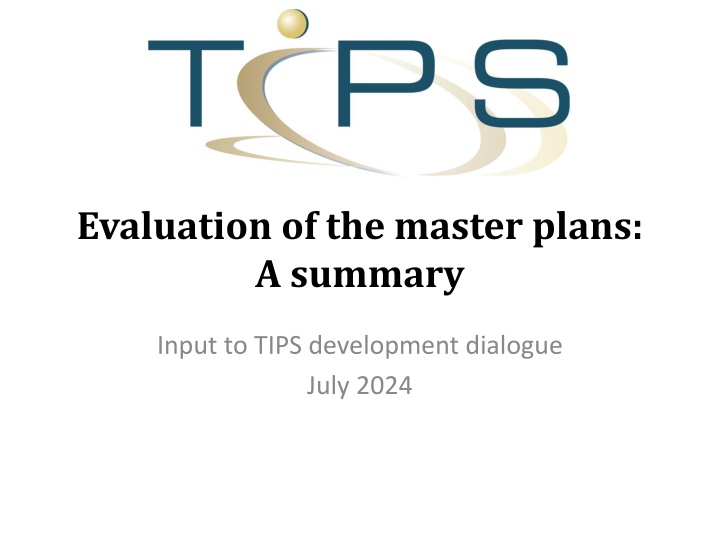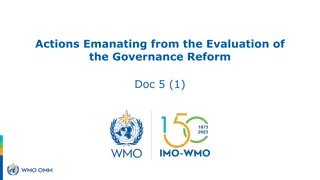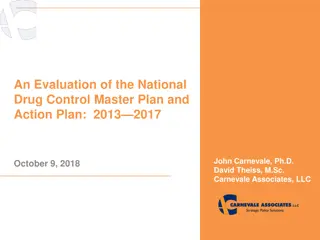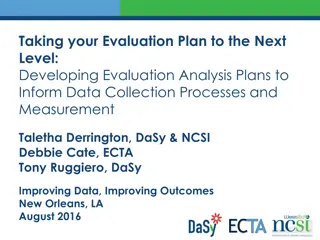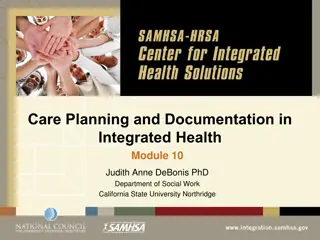Evaluation of the master plans: A summary
This summary input discusses the evaluation of master plans in South Africa, five years after their introduction, focusing on methodology, challenges, and innovations in the master plan project. It also highlights the structural changes and aims for industrial policy.
Download Presentation

Please find below an Image/Link to download the presentation.
The content on the website is provided AS IS for your information and personal use only. It may not be sold, licensed, or shared on other websites without obtaining consent from the author.If you encounter any issues during the download, it is possible that the publisher has removed the file from their server.
You are allowed to download the files provided on this website for personal or commercial use, subject to the condition that they are used lawfully. All files are the property of their respective owners.
The content on the website is provided AS IS for your information and personal use only. It may not be sold, licensed, or shared on other websites without obtaining consent from the author.
E N D
Presentation Transcript
Evaluation of the master plans: A summary Input to TIPS development dialogue July 2024
Aims and methodology Five years since introduction of master plan approach Evaluation should help identify new opportunities and areas for improvement Methodology: Review of overall master plans project Individual plans analysed as main mode of implementation, with four reviewed in more depth as case studies Problem that no published policy document draw on presentations and speeches Re-imagined industrial strategy (RIS) documentation only discusses process for objectives, use the overall dtic vision: A dynamic, industrial, and globally competitive South African economy, characterised by meaningful economic transformation, inclusive growth and development, decent employment and equity, built on the full potential of all citizens.
The master plan project Five main innovations Well-defined aims for industrial policy to guide master plans Focus on a few prioritised industries to enable scaled up support Close collaboration with industry stakeholders (established business and organised labour) platforms and engagement are more important than the published document Evidence-based approach with on-going evaluation and learning Increased resourcing and alignment across the state to implement master plans Effective theory of change: 1. Government sets the main impacts and outcomes for industrial policy, and by extension the master-plan project and the master plans for individual industries. 2. Government identifies a limited number of priority industries that, as a group, can accelerate inclusive growth, by expanding economic opportunities and/or driving faster growth. 3. For each priority industry, government establishes a platform with formal business and labour to develop joint initiatives to achieve agreed-on aims. 4. The stakeholders agree on effective actions to support inclusive growth in the industry, testing proposals against the evidence so as to ensure realistic and effective approaches. 5. The stakeholders set up governance structures to drive implementation effectively conditions and needs. 6. The stakeholders allocate capacity and resources on the scale required to drive the structural changes required, with alignment across government to implement industry-level measures. 7. Large-scale, innovative measures accelerate economic growth in the master plan industries, which expands both competitive capacity and economic opportunities while responding to changing
Aims and prioritisation Aims Not specified in re-imagined industrial strategy Have to balance upgrading established business opening up new opportunities through new clusters and producers Master plan guides (2023) recommend methods developed to define business needs (Pestel + Porter s 5 forces), not socio-economic imperatives Prioritisation Original proposal: Identify limited number of industries that can drive structural change as a group Prioritisation should enable Scaled up resourcing Alignment across the state Manage lobbying Started with list of 13 covering most of the economy; of those: 6 published; 4 published but not on list, 3 of which are very small; 5 underway that not on list and all small except construction 30% Creative (d) Furniture 25% CTFL 20% Auto 15% Wood/Paper Steel value chain Sugar 10% 5% Poultry Other agriculture 0% GDP (a) investment (b) private formal goods exports goods imports
Strategies and measures Use of evidence No new systems to commission, obtain or use evidence No clear narrative on cost drivers or inclusion, and little evidence on government and stakeholder proposals Range: Auto: an expert input on broad economic imperatives Steel: no visible research base at all Stakeholders Only formal business and labour Working class consumers, most small businesses, jobless and municipalities not represented except through national departments Master plans Did not evaluate impact of tariffs and local procurement on prices and on government services Do not open new opportunities for small business on a large scale except in forestry (where not implemented); agreed limits on land reform Strategic narrative Imperatives: Growth ultimately requires improved competitiveness Need to generate opportunities on a mass scale Master plans: Very hard to discern strategic narrative Business lobbying for protection, local procurement and better government services Not interested in fights around supplier prices and rents (e.g. soya, textiles, iron ore and coal) Disruptive technological change is also divisive and difficult for many established businesses (e.g. poultry, steel, EVs) Government focused on black ownership and target setting Alignment across the state Project does not specify new platforms or systems (engagement, mandating, dispute settlement, capacity) No link to government expenditure or SOCs Master plans Do not propose large-scale increases in resourcing but do ask for improvements in infrastructure limited success in implementation Average incentive is around R500 million per industry, compared to R30 billion for auto
Some outcomes Examples: Industry-level platforms have been unable to deal with crises at Eskom and Transnet As a group, the master plan industries saw slower increase in import intensity than other industries, but only historic commodity exports climbed significantly (mostly due higher world prices) Some industry examples: No change to APDP incentive scheme and consequently in local and regional sales, which master plan document saw as central pillar for growth along value chain Chicken imports down but domestic production did not increase as fast, while feed prices escalated in 2022 - IQF chicken prices rose 2,6% faster than inflation from 2020 to 2023, and consumption per person fell Sugar imports from eSwatini fell while price restraints were in place, but since then have increased as producer price increase jumped 25% in 2023 In steel, debates over scrap underscore tensions between established and emerging business Similar issues around rebate for textiles progress on woven material but delays on knits Cannot evaluate impacts due to series of crises from 2020 Relatively small share of economy means that even if reached targets: Growth: master plan industries would accelerate from 1,6% to 4,3% - but national growth only up by 0,2% Employment: master plan industries would accelerate from 1,1% to 2,0%, but national formal jobs growth would increase by only 0,1% Share of adult population with formal employment would climb from 27,9% to 28,2% by 2030
Impact on socio-economic groups Established formal business: Benefits: Government works to improve ecosystem; import protection; improved government services and financing Costs: Engagement; support for black- owned businesses; price restraint in sugar and poultry; funding for industry institutions and funds; retailer commitment to local procurement in sugar and CTFL Risks: Process fails due lack of government alignment and socio- political pressures Unemployed/informal: Benefits: Accelerated growth may open some opportunities and increase public revenues Risks: Reinforce path dependency, so government less likely to drive changes in production structure or ownership to expand opportunities on scale In practice, ignore most labour-intensive industries, especially services; limits on land reform Small and emerging business: Benefits: Accelerated growth and some targeted support Costs: Capacity to engage Risks: Measures favour established business e.g. in tariffs on inputs and provision of infrastructure Government departments and agencies Benefits: Growth increases incomes and employment; producers may use relief from competition to upgrade production Costs: Capacity to manage process, including lobbying by established businesses and resources for industry-level structures; resourcing for specific measures Risk: Disappointed partners if cannot deliver Working-class consumers: Benefits: Growth increases incomes and employment; producers may use relief from competition to upgrade production, ultimately moderating prices Costs: Higher tariffs raise prices on some consumer staples, notably poultry and clothing
Some proposals Every master plan should commission a research-based strategic narrative that identifies: cost drivers, including an evaluation of input pricing, technologies, skills and infrastructure; structural changes to scale up employment and self employment innovations around products and who pays, ownership and employment systems, intermediaries Long-term targets (2035) for industrial policy that measure progress in terms of: stepped up employment and self- employment (faster than GDP growth); Reduced mining dependence Ambitious but realistic growth targets More rigorous selection of master plan industries As group should help achieving long run aims Significant improvement in resourcing once selected Government engagement: Streamline governance structures, delegate more, and mandate national priorities for the industry Agree on measures with all affected government agencies before sign off, including representation on platforms (which has costs) Formally evaluate impact on consumers, small business and municipalities before finalising any proposals Formalise systems for industries not included in the master plans, especially when they face a crisis Define the roles of sector desks advocacy/unblocking, monitoring, policy development?
Implications for industrial policy Changes in the way the state functions: Industrial policy has to meet SA s unique needs Specify long-term goals to help ensure we stay on the right track Walking on two legs: Massively scale up programmes to create opportunities and empower our people through innovative programmes (products, ownership, financing, intermediaries) Help established producers become more competitive, rather than just protecting them from competition Unambiguous prioritisation of a few key aims and programmes as basis for alignment across the state Reallocation of capacity within the dtic Management of risks resulting from structural change, rather than just avoiding them
